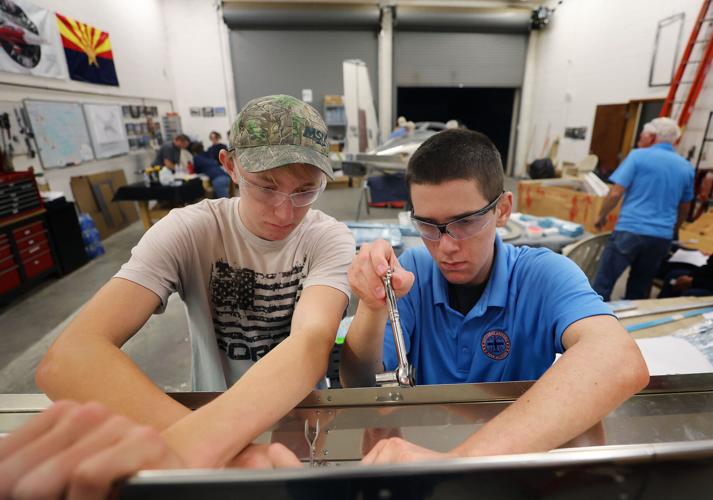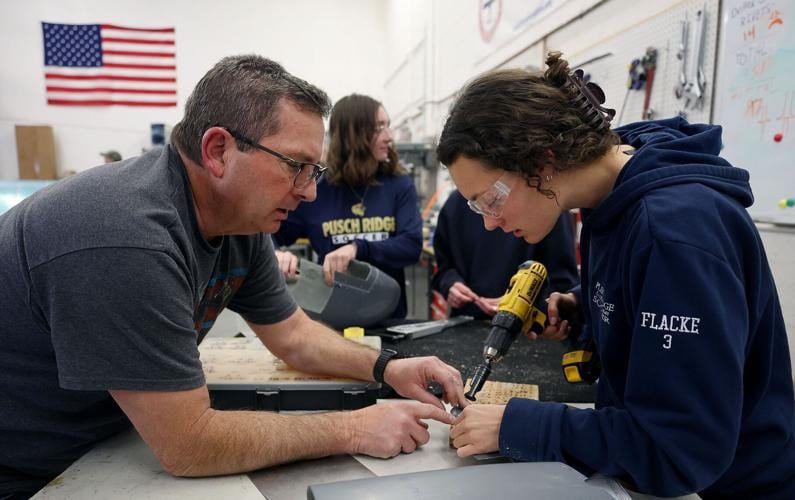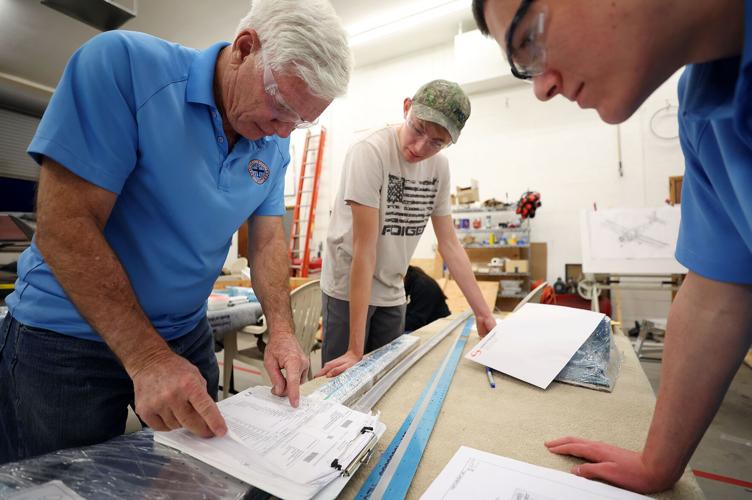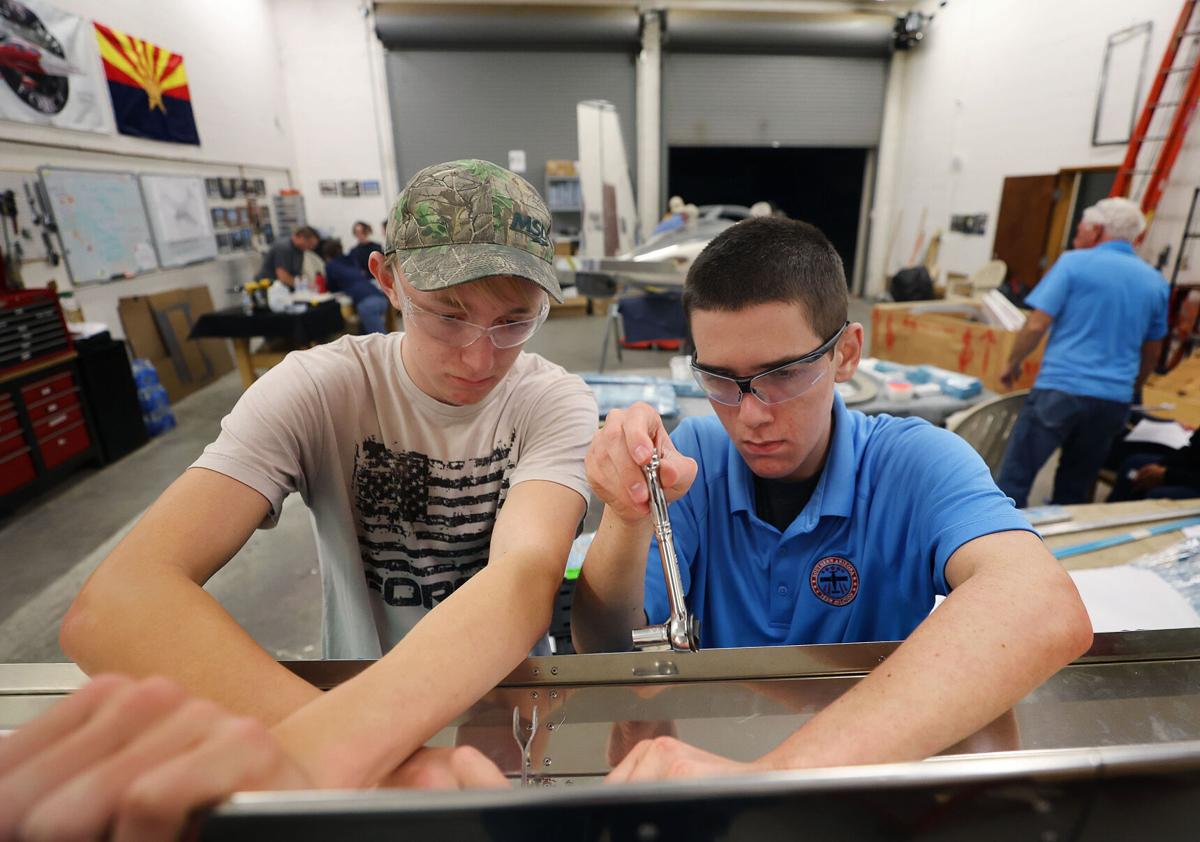At 5:30 p.m. nearly every Monday, a group of 10 local teenagers walk into a large garage on Tucson’s northwest side.
No, they’re not getting ready for band practice, studying the latest TikTok dance, learning to work on a broken-down car or any other cool teenage activity you might typically find happening in a garage nowadays.
As they put on their safety glasses, they begin working on something much bigger.
They’re building a small airplane.
It’s not unusual for teens to participate in extracurricular activities after school. They might volunteer at soup kitchens, play sports, practice musical instruments and join clubs.
However, local nonprofit Southern Arizona Teen Aviation is taking extracurriculars to new heights with its free plane-building program that hopes to ignite a love of aviation in teens.
“We love aviation obviously, and we tried to figure out ways to engage kids,” said Alan Muhs, the co-founder of SATA and a pilot with several decades of experience. “I think as adults, we have a responsibility to help the next generation be successful. And I look at this program as giving them an opportunity to experience something that (they) probably wouldn't otherwise. (We) give them an opportunity to discover something they're interested in. And some kids come in, they're interested. Some kids come in and they're not. But at least they have a chance.”
Throughout the three-hour Monday evening session, the teens work on various parts of the RV-12 airplane — a small, single-engine, two-seater aircraft from Van’s Aircraft — that’s about 90% completed as we're writing this.
Some are using a rivet gun to secure rivets into the plane’s ailerons, while others are working on the wiring of the aircraft’s avionics (under the supervision of one of SATA’s many mentors, of course).
Although they are working on a serious project, you can’t help but be reminded of their youth as they crack a joke or two and make (almost) harmless bets with one another about shaving off an eyebrow for the person who finishes their rivets last.

Alan LaFever, left, a mentor, helps Ally Flacke, 17, with drilling.
The 10 student participants consist of five girls and five boys — sophomores through seniors from various local high schools including Catalina High School, Amphitheater High School, Ironwood Ridge High School, Pusch Ridge Christian Academy and Catalina Foothills High School. This is the program's first year with an equal amount of boys and girls. Typically, it's primarily boys.
Many of the teens heard about SATA through one of their high school science classes and thought the program sounded like a good opportunity to learn about aviation while meeting new people.
Senior Amanda Miranda was one of the only students to join the program after her mother discovered the program online. It’s her first and last year in the program because she's a graduating senior, but she says she’s enjoyed the journey so far.
“This is kind of unrelated to the aviation aspect, but I think (my favorite part is) meeting a bunch of older people and talking to them and seeing their perspectives,” she said. “Talking to them about going to college or figuring out the next step. Their perspective is cool to see. We hear a bunch about their experiences and how they got into aviation and how I can get into aviation, too.”
Like many others in the program, Miranda aspires to have a career in aviation. She says she can see herself becoming a commercial airline pilot.

Alan Muhs, founder, left, looks through an inventory list as Fenton Goldener, middle, and Noah Parrish watch.
For second-year participant Noah Parrish, joining the program was the first step in honoring his grandfather’s legacy as an engineer and pilot.
“It’s been great,” he said. “I’ve learned so much about tools and working on planes and anything with planes.”
He says after his final year in the program next year, he wants to become an aerospace engineer, start his own space company and send people to the moon.
Similarly, junior and first-year participant Fenton Goldener hopes to become a helicopter pilot for the Army after high school.
“Just coming here and not only being able to build an airplane but also getting to talk to people like Noah, Sarah, Amanda and talk with my mentors like Mr. Chabolla, Mr. Sanchez, it’s all great,” Goldener said.
First-year participant Sarah Zuber plans to become a veterinarian or an aerospace engineer and became involved in the program to see if she would truly enjoy an aviation career or if she wants to stick to the veterinarian path.
“I love working here. I didn’t even know how to use a drill when I first got here, so it’s been very informative and I know how to do a bunch of things now,” she said, adding: “I like all the opportunities it gives us but I also really like working with the metal and riveting and the (overall) hands-on experience of it.”

Sarah Zuber, 15, scribbles a note underneath the flaperon.
SATA currently meets weekly on Sunday afternoons and Monday evenings to work on their current aircraft. Since the program is centered around teens, the organization follows an academic calendar.
For safety reasons, the program is capped at 10 students per academic year. The application period for the next academic year is scheduled to open next month, according to Muhs.
“We teach them to work together, how to read the plans, how to do inventory, how to use the tools and they’re getting a wealth of experience and knowledge and growth,” Muhs said. “There's no shop classes in high school anymore. There are no hands-on (opportunities) in the classroom. They get lectures, they do tests, and maybe in science classes, there's a little bit of that (hands-on experience). We tell them when they come in there’s no test, no homework. But we do expect you to come and work and give the effort that we all believe it deserves and should have.”
‘We love aviation. We love sharing it with young people and we love helping them be successful.’
SATA has worked on this particular RV-12 aircraft for a couple of years, mostly due to a pause in the program and shipping delays during the height of the COVID-19 pandemic. Typically, it can take between 700 and 900 hours for experienced builders to put together this aircraft, according to Van’s Aircraft’s website.
Muhs and the rest of SATA chose the Van’s Aircraft RV-12 because it’s the only small aircraft kit in the country that comes with everything you need. The kit comes with the engine, wings, frame, canopy — you name it. The total kit cost around $110,000, Muhs says.
“This airplane comes complete. So we can take it from beginning to end,” Muhs said. “And they (teens in the program) do all the work. We get involved once in a while when things go south. But one of the things I really impress upon them is this is a safe place. … We're not going to give you a hard time if you make a mistake. I expect you're going to make mistakes and I want you to learn how to fix mistakes. You're gonna make mistakes your whole life. You learn how to fix them, how to get past them and how to move on. So, we just tell them when they make a mistake, ‘Fess up, let's figure it out.’”

Logan Franke, 18, works on some wiring underneath the plane.
The RV-12 that the current SATA teens are working on is the organization’s third plane. Like their previous aircrafts, once completed, they test-fly the plane, take the teens for rides and then begin the selling process to raise additional money for more RV-12 kits.
As a nonprofit, SATA primarily runs on monetary and resource donations. The current workshop garage that SATA works out of is owned by construction contractor Matt North, a friend of Muhs who lets the organization utilize it free of charge. Locals Joey and Neal Bowker also provided an airplane hangar at Ryan Airfield that SATA can use for free as they test, store and even work on planes.
Of course, there’s an invaluable donation made to SATA every week — the time and knowledge of the organization’s volunteers who mentor teens in the program.
SATA’s mentors come from a variety of backgrounds including ex-military members who flew fighter jets and helicopters, commercial airline pilots, flight instructors, a public safety helicopter pilot, an electrical engineer from Boeing and more.
Altogether, the mentors have decades of experience and thousands of hours of flying time.
“I really wish when I was thinking of doing this that there was somebody I could’ve asked questions to about the military, about commercial (flying), about everything and there wasn’t,” said Miguel Chabolla, a SATA mentor and former military pilot and commercial pilot for United Airlines. “So, I love being available to them to answer any questions or give them some guidance or whatever they need.”
One of the newer mentors is 21-year-old Wyatt Scott — a certified aircraft mechanic who currently works for SkyWest Airlines. Scott was a SATA student back in 2018 and returned to SATA as a mentor in 2021.
“Everybody starts somewhere and I had people helping me from where I was to where I am now and I figured that it would be a good thing to come back and continue the program. But also, it’s cool working on airplanes. So, if I have an excuse to come work on an airplane, I’m going to,” Scott said.
Scott credits the program with helping him find a direction career-wise after high school.
“We have a wide variety of experiences as far as builders, mechanics, pilots,” he said. “Even if you’re not here to work on airplanes, you get to fly them, you get to talk to people who have flown them, you can talk to people here about a career path and where you want to go after high school and that’s very valuable for students.”
Since its founding in 2017, Muhs estimates that between 60 and 70 local teens have participated in the program. Many past participants have gone on to become pilots in the military, flight instructors and engineers.

Joanie Tarleton, 16, uses her head to hold up a piece underneath the tail of the plane during a work night for the Southern Arizona Teen Aviation program on Feb. 19.
“We've had a lot of great kids come through here and it's just wonderful to spend time with them,” Muhs said.
As for what’s next for SATA, the team plans on finishing their current project aircraft — their third RV-12 — this summer, followed by putting more work into their fourth aircraft which they have already started. They also hope to have a livestream of their workdays up on their website soon.
More importantly, they’re looking forward to continuing their mission of helping local teens find a passion for aviation, whether that’s professionally or just as a fun hobby.
“I'm very happy where it's going right now. We bring our kids in, we spend time with them. I get to meet a lot of really neat young people,” Muhs said, adding: “We’re a bunch of retired guys, for the most part. We love aviation. We love sharing it with young people and we love helping them be successful.”
For more information about Southern Arizona Teen Aviation, check out their website.












